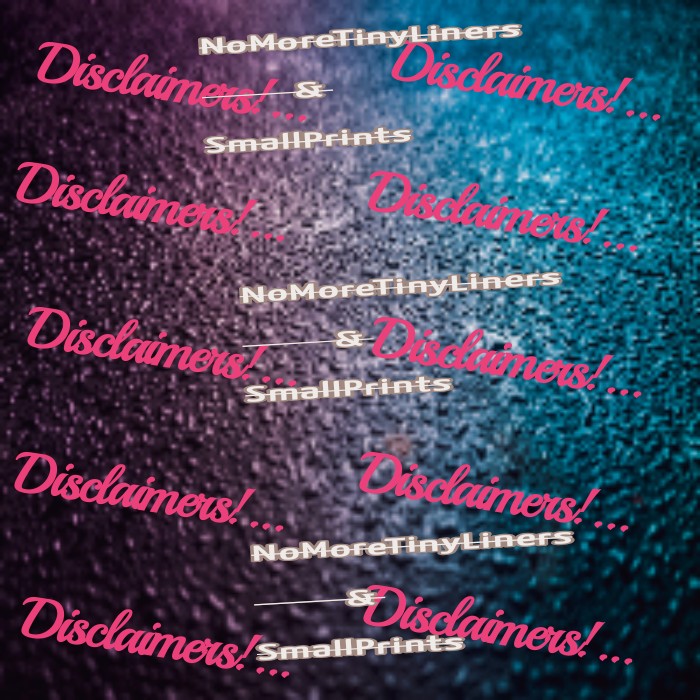
Risks are inherent in all kind of businesses and businesses without risk are nearer to impossible. Comprehensive disclaimer/s can go a long way towards mitigating and reducing those risks and helps in safeguarding your investment & efforts. The areas of risks you identify guides you through your choices of disclaimers to include & details to be incorporated therein.
Why Disclaimers? Inclusion of appropriate disclaimers considering the business need and type of risks acts as an added layer of protection to safeguard to business. Disclaimers are important & integral part in ensuring your customers are aware of potential risks and thereby protecting your business against the liability & risks. Failure to include disclaimers may wide open the potential liability.
Disclaimers are ways to inform, instruct, caution, warn, address, protect, avoid violation of law, exclude to limit the liability, and risks.
Disclaimers mainly serve the following purposes:
- Disclaimer helps in limiting your legal liability
- Disclaimer keep your users informed
- Disclaimer may be a legally requirement
- Disclaimer part of compliance
- Disclaimer to protect personal content
- Disclaimer for information
- Disclaimer to issue warning
- Disclaimer to instruct the user or customer
- Disclaimer to exclude risk
What Type of Disclaimers Business should Use? Enormous types of disclaimers are used by the businesses depending upon the need and situation to avoid and reduce the risks. Like legal disclaimers, email disclaimers, professional liability disclaimers, intellectual property disclaimers, website disclaimers, copyright notice/ disclaimers, errors and omissions disclaimers, third party disclaimers, medical disclaimers, fitness disclaimers, confidentially disclaimers, day today disclaimers and sign boards.
Day today disclaimers are pretty simpler usually does not require professional help and can be easily managed by the needy themselves. For example, “Park at your own Risk”, “Be Aware of Dog”, “Go Slow”, “Keep Left” and so on and so forth.
But if the transaction or service or product is complex and involves high stake then requires detailed and comprehensive disclaimers in order to protect business and exclude the feasible liability if not then at least the cap the liability.
Many a times identifying risks itself may be big challenge for the business then definitively it requires legal help. Expert legal professionals can help to identify the main legal risks for your business, which disclaimers may of help to your business and how a legal disclaimer might work for you and your business along with how to do it right and so on.
Are Disclaimers Legally Binding in India and can be Enforceable as Contracts? It is debatable and legal position is not clear. So, disclaimers better to be part of terms and conditions or agreement you are entering into with the user or customer in order to make them binding. Disclaimers can be legally binding as long as they are not unfair and users gets chance can review them with option to accept or reject these disclaimers. But yet in case of clickwrap it is difficult to enforce as user as no other option and needs to accept the terms especially when the terms are not reasonable.
Does A Disclaimer Exclude Business from All Types of Liability? No, excluding the liability by mere inclusion of disclaimer is not possible. When disclaimer/s are against the public policy or completely excluding the liability against statutory duty, avoidance of contractual duty which business has obligated to do. Plus, unfair terms of disclaimers can’t exclude the liability. Hence complete exclusion of business risks and liabilities is not possible.
No one can avoid legal obligations and compliances irrespective of the number of disclaimers and waivers puts in and wants to take shelter thereunder.
However, fair disclaimers with legal compliance and fulfilment of statutory obligations as well as contractual obligations which are not against the public policy helps the business in mitigating and reducing the risks and liabilities.
Why Disclaimers are in Tiny Fonts & Small Print? Are you curious why declaimers are in form of tiny font and small print most of the time? We guess no one likes to read them and they take up a lot of space which is otherwise very useful for the commerce. The other obvious reason may be is due to fact these this disclaimer on main part and in big font may affect sales / services or reduce even the potential business. Ultimately, unless someone is really keen these tiny fonts & small prints loses glass of customer/users towards the disclaimers.
From customer/ user point of view, these tiny font and printed disclaimers are relevant to understand the risks they are taking or what caution they are supposed to take or information they need to be aware of. But yet these disclaimers are usually ignored or neglected due to their inherent nature of tiny font and small prints. Thereby disclaimer/s is the elephant in the room. Give it good read before accepting these disclaimers and know what are accepting.
Does India is having law to deal with problem of tiny fonts and small print of Disclaimers??: Yes, very recently Indian govt has issued guidelines to deal this problem. Advertisements using small fonts for disclaimers will be considered as misleading as per Consumer Protection Authority (Prevention of Misleading Advertisements and Necessary Due Diligence for Endorsement of Advertisements) Guidelines, 2020. Font size of the disclaimer should be the same size as the claim made by the advertisement. Disclaimers which are not easily noticeable or understandable to the consumer are also considered misleading advertisements. Be aware that misleading advertainments may attract the penalties.
Disclaimers made in supporting, limiting or explaining claims made in advertisements in any form needs to follow aforesaid the guidelines and line with following:
- A Disclaimer can expand or clarify a claim, make qualifications, or resolve ambiguities, to explain the claim in further detail, but should not contradict the material claim made or contradict the main message conveys by the advertiser or change the dictionary meaning of the words used in the claims received or perceived by a consumer.
- A disclaimer should not attempt to hide material information with respect to the claim, the omission/ absence of which is likely to make the advertisement deceptive or conceal its commercial intent.
- A disclaimer should not attempt to correct a misleading claim made in an advertisement.
- A disclaimer shall be in the same language as the claim of the Advertisement.
- The font should be in the same font as the claim.
- Placement position of disclaimers of a claim on packaging should be in a prominent and visible space and could be ideally on the same panel of the packaging as the claim made.
- If the claim is presented as voice over then the disclaimer should be displayed in sync with the voice over
- A disclaimer should be clear, prominent enough and legible.
- Disclaimer should be clearly visible to a normally-sighted person reading the marketing communication once, from a reasonable distance and at a reasonable speed.
Inference & Suggestions:
Mostly disclaimers are optional in nature to reduce risks and liability of business and very few disclaimers are mandatory & regulated by law.
Though primarily the disclaimers are added at the end space in tiny font and small print but they speak volume in terms of risk and liability. These tiny liners are shield to business and if ignored may be sword. But now law of the land requires disclaimer should be clear, prominent enough and legible.
It is always better to reduce and prevent risks than completely avoiding, by adopting the pre-emptive measures via appropriate disclaimers to protect your business against the risks and liabilities. Wide and opened liabilities should be capped to extent possible in line with the applicable laws upon fulfilment of statutory duties.
Limited liability is permitting in law and not avoidance of liability altogether. Hence please be heedful of difference between limiting and avoiding liability while using disclaimers. Disclaimers act as boon to the business when aptly used but otherwise it can be bane.
Better safe than sorry include disclaimer and disclaimer should be clear, prominent enough and legible. Disclaimers need to provide more information to users if not then defeat the purpose. Plus avoiding the flash and tiny disclaimers is need of the hour to be complaint with the law.
Know the risks, know the laws and know the extent of limits to include apt disclaimers and its content thereon. Get expert legal professional help wherever needed. Use the words wisely to have crisp yet effective disclaimer to shield your business. Disclaimers are definitely added layer of protection if used in business prudence.
Disclaimer: The information provided under this website is solely available for informational purposes only, should not be interpreted as soliciting or advertisement. We are not liable for any consequence of any action taken by the user relying on material / information provided under this website. It’s not legal opinion in cases you have any legal issues then in all those cases you must seek independent legal advice.
* Write up by Team Purple Pursuits, for more details you can reach to us [email protected]




